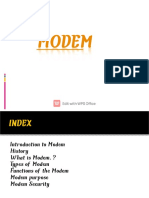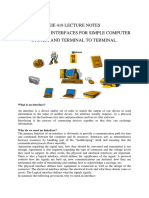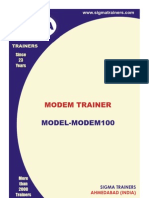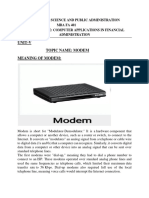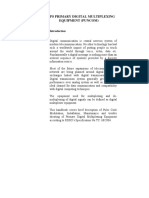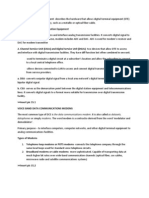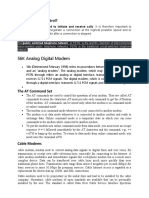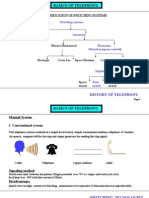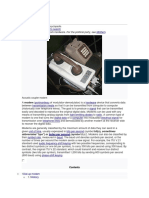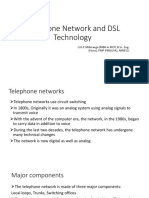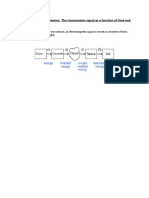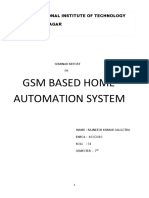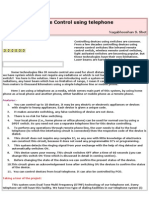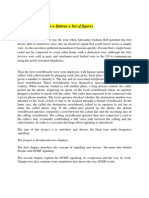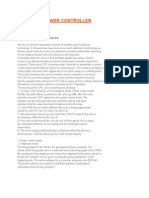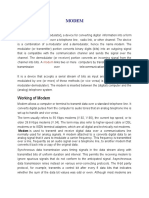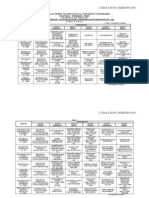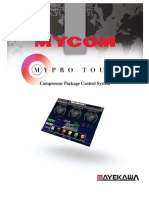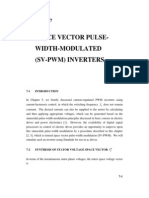Modem
Modem
Uploaded by
sriramCopyright:
Available Formats
Modem
Modem
Uploaded by
sriramCopyright
Available Formats
Share this document
Did you find this document useful?
Is this content inappropriate?
Copyright:
Available Formats
Modem
Modem
Uploaded by
sriramCopyright:
Available Formats
-1-
DUCTION:
INTRO
Modem is contraction of modulator-demodulator. It is a special communication box which uses the data signal to modulate a waveform usable with the telephone system. The term modem has also come to mean any communication box that makes a digital data signal compatible with any nondigital system and medium besides the phone system. An e.g. is a modem which makes the data bits compatible with a microwave radio system. The theory and application of modems comprise the area in which all the previous concepts of Fourier analysis, modulation, bandwidth and equipment. The modem acts as the electronics bridge between two worlds the world of purely digital signal and the established analog world, such as the telephone system. Modems are always used in pairs. Any system -whether simplex, half duplex or full duplex, requires a modem at the transmitting end and at the receiving end. The modems do not have to be from the same manufacturers but in all aspects of communication, they should use an agreed set of rules.
CITC (IT)
-2-
KEY IDEA:
The concept is to use tones of various frequencies, phases or amplitudes to represent the binary data. Tones are what the phone system is designed to handle, since the voice is made up to many tones combined. Different modems use frequency modulation, amplitude modulation, phase modulation amplitude modulation, or some combinations of these to achieve the desired data rate and low error performance over different types of telephone lines.
CITC (IT)
-3-
FUNCTIONS:
AT TRANSMITTING END:
Take data from RS-232 interfaces. Convert these data into the appropriate tone. Perform line control & signaling to the other end of phone line. Send dialing signals if modem is designed to dial without user present. Have protection against line over voltage condition & problems.
AT RECEIVING END:
Receive tones from the phone line. Demodulate these tones into 1s & 0s. Put the demodulated signals into RS-232 format& connect to the RS232 interface. Perform line control & signaling. Have protection against the over voltage problem.
CITC (IT)
-4-
BLOCK DIAGRAM
T o D T E
Tone generation & receiving RS-232 Interface Timing & control
telephone line inter face
P H O N E L IN E
Line control
A modem is designed to interface data signals to phone lines. It contains interfaces to the phone line, the DTE, tone generation & receiving circuit, & line & timing control circuit.
CITC (IT)
-5-
OPERATION :
The main activity of a modem is to send & receive digital data. Consider a case in which the modem uses two frequencies to represent the two binary values. Suppose 1000Hz is used for the binary 0 & 2000Hz is used for binary 1. A stream of bits then is converted into 1000 & 2000Hz tones, & these tones go on the phone line. By design the phone system can handle these tones reasonably well as compared to put in simple voltage of 0v & 5v on the line. The rate at which the 1000 & 2000Hz tones are used to represent the data bits is the band value in use. In a 300 baud system, there is a new bit every 1/300s, if the bit has the same value as the preceding one, the tone is unchanged. If it were different, then the tone would be different. Consider a stream of the data bits like the following 10011010. The phone line receives the following signals as shown in figure.
CITC (IT)
-6-
At the receiving end, the modem must be prepared to look for the 1000 &2000-Hz signals despite their low signal level continuous variation in the level and the addition of corrupting noise. To do this, receiving circuitry in the modem uses designs that amplify the weak signals special techniques that can reduce the noise & demodulate the signal, & filters tuned to 1000 & 2000-Hz. The output of the filter circuit goes to a signal detector, which sees which filter has an output at any instant of time. If the 1000Hz filter has an output, then a 0 must have been received; an output at the 2000Hz filter indicates that a 1 was received. The modem uses its timing circuitry to reformulate a string of 1s & 0s from the received tones that is identical to the string of 1s & 0s that the equipment at the transmitting end generates.
CITC (IT)
-7-
SPECIFIC MODEMS:
There are some specific modems which are listed below: The bell 103 The bell 212 The bell 202 Direct connection modems Fiber optics modem Digital modem Multiplexer & concentrator modem.
1. 2. 3. 4. 5. 6. 7.
CITC (IT)
You might also like
- Bedini's Free Energy Generator PDFDocument7 pagesBedini's Free Energy Generator PDFRafly Attila Al-Fiqri78% (9)
- LAB GROUPEN Conversion Table - Power Rating To MaxPeak and ISVPLDocument1 pageLAB GROUPEN Conversion Table - Power Rating To MaxPeak and ISVPLluz.negociosenlineaNo ratings yet
- Parts Manual - UL: Wayne Helix™ DispenserDocument218 pagesParts Manual - UL: Wayne Helix™ DispenserJosé Luis QuirozNo ratings yet
- Essential 4G Guide: Learn 4G Wireless In One DayFrom EverandEssential 4G Guide: Learn 4G Wireless In One DayRating: 4.5 out of 5 stars4.5/5 (12)
- Modem Usb 300 BaudDocument4 pagesModem Usb 300 BaudGraure SorinNo ratings yet
- 10928139Document71 pages10928139NgôĐứcQuânNo ratings yet
- ModemsDocument19 pagesModemsAdeel MansoorNo ratings yet
- DTMF Based Home AutomationDocument28 pagesDTMF Based Home AutomationRenjith RavikumarNo ratings yet
- Mobile Controlled Electrical ApplianceDocument17 pagesMobile Controlled Electrical ApplianceSmile AravindNo ratings yet
- Data Communication Modems: by Clark C. Lugartos and Sherwin Brenz F. OcampoDocument44 pagesData Communication Modems: by Clark C. Lugartos and Sherwin Brenz F. OcampoShebNo ratings yet
- B.E. - 1st Year EC-2 (B-3)Document23 pagesB.E. - 1st Year EC-2 (B-3)skNo ratings yet
- Eie 418 Lecture Notes Interfacing: Interfaces For Simple Computer System and Terminal To TerminalDocument16 pagesEie 418 Lecture Notes Interfacing: Interfaces For Simple Computer System and Terminal To TerminalJames JamessNo ratings yet
- 34 Modem100Document16 pages34 Modem100CauVong JustinNo ratings yet
- Unit-V Topic Name: Modem Meaning of ModemDocument11 pagesUnit-V Topic Name: Modem Meaning of ModemMuhammad SaadNo ratings yet
- Remote Control of Electrical Appliances Using GSM Networks: Abah O. Sunday Visa M. Ibrahim Abah JoshuaDocument8 pagesRemote Control of Electrical Appliances Using GSM Networks: Abah O. Sunday Visa M. Ibrahim Abah JoshuaIJERDNo ratings yet
- Mobile Computing Through TelephonyDocument65 pagesMobile Computing Through TelephonyPrakash Patil100% (10)
- 2MB Mux PDFDocument114 pages2MB Mux PDFRohit Sharma100% (1)
- Synchronous ModemsDocument6 pagesSynchronous ModemsMr Asraf AllyNo ratings yet
- Synchronous Modems: Synchronous Data Phase Modulation Integrated Phase and AmplitudeDocument6 pagesSynchronous Modems: Synchronous Data Phase Modulation Integrated Phase and Amplitudea2kashNo ratings yet
- Data Communication EquipmentDocument6 pagesData Communication EquipmentCarlo Guzon100% (1)
- What Is Modem ControlDocument4 pagesWhat Is Modem Controlbibek kumarNo ratings yet
- Public Switched Telephone Network (PSTN) : Voice and Data Delivery NetworksDocument180 pagesPublic Switched Telephone Network (PSTN) : Voice and Data Delivery NetworksAlas Mallari DonatoNo ratings yet
- Interactive Voice Response SystemDocument17 pagesInteractive Voice Response SystemSowjanya ModalavalasaNo ratings yet
- ET02 (Upload-Ver)Document51 pagesET02 (Upload-Ver)Erman HamidNo ratings yet
- AB - CCNA Voice Quick Reference GuideDocument31 pagesAB - CCNA Voice Quick Reference GuideSrdjan MilenkovicNo ratings yet
- ECN 302 NotesDocument16 pagesECN 302 NotesShrey SuriNo ratings yet
- Micro Controller Based RF Rbotic CarDocument66 pagesMicro Controller Based RF Rbotic CarPradeep VermaNo ratings yet
- Basics of TelephonyDocument35 pagesBasics of Telephonyarvind2431100% (4)
- Sylabus TssDocument30 pagesSylabus TssMavra ShahidNo ratings yet
- Principles of Electronic Communication Systems: Second EditionDocument60 pagesPrinciples of Electronic Communication Systems: Second EditionThiruGovindNo ratings yet
- ModemDocument3 pagesModemshohobiNo ratings yet
- Term Paper On Tele CommunicationsDocument19 pagesTerm Paper On Tele CommunicationsSurendra_Babu__1674No ratings yet
- Overview of ProjectDocument14 pagesOverview of ProjectdbpalNo ratings yet
- Interactive Voice Response System Seminar ReportDocument19 pagesInteractive Voice Response System Seminar ReportMurali Dhar Kankati100% (1)
- A2Z Control SystemDocument4 pagesA2Z Control SystemZatin GuptaNo ratings yet
- Telephone Network and DSL Technology: U.K.P. Mihiranga (MBA in MOT, B.Sc. Eng. (Hons), PMP-PMI (USA), AMIESL)Document37 pagesTelephone Network and DSL Technology: U.K.P. Mihiranga (MBA in MOT, B.Sc. Eng. (Hons), PMP-PMI (USA), AMIESL)Pathum MihirangaNo ratings yet
- B.E. - 1st Year EC-2 (B-3)Document23 pagesB.E. - 1st Year EC-2 (B-3)skNo ratings yet
- The Main Objective of The Project Is To Control The Functioning of The Industrial/Agricultural Load Using Wireless TechnologyDocument3 pagesThe Main Objective of The Project Is To Control The Functioning of The Industrial/Agricultural Load Using Wireless TechnologyMadhurima DeyNo ratings yet
- I DenDocument34 pagesI DenGajendra SettyNo ratings yet
- Dcom Notes 11Document22 pagesDcom Notes 11Aparna RajeshNo ratings yet
- WMCDocument53 pagesWMCkirtidahiya123No ratings yet
- ModemDocument1 pageModemNoopur DograNo ratings yet
- GSM Based Home Automation System: National Institute of Technology SrinagarDocument19 pagesGSM Based Home Automation System: National Institute of Technology SrinagarSubham PalNo ratings yet
- Dgital Communication LecturesDocument202 pagesDgital Communication LecturesmgoldiieeeeNo ratings yet
- Mt8870 DTMF DecoderDocument17 pagesMt8870 DTMF DecoderLawrence NgariNo ratings yet
- ISDN BasicsDocument112 pagesISDN BasicsRajurajiNo ratings yet
- Device Control Using Telephone: Nagabhooshan S. ShetDocument15 pagesDevice Control Using Telephone: Nagabhooshan S. ShetNicholas TaliNo ratings yet
- Objective & MotivationDocument15 pagesObjective & MotivationHimanshu SuranaNo ratings yet
- Cisco Voice T1, E1, IsDN Configuration and TroubleshootingDocument21 pagesCisco Voice T1, E1, IsDN Configuration and Troubleshootingtimbrown88No ratings yet
- Govt. Polytechnic, Sakoli: ModemDocument16 pagesGovt. Polytechnic, Sakoli: ModemRavi JoshiNo ratings yet
- Project Report: On BSNLDocument23 pagesProject Report: On BSNLumairkhan012No ratings yet
- Modem StandardsDocument28 pagesModem StandardsPonmani SelviNo ratings yet
- Bdak Tzed 2wal Saf7a W Lfahras W List of FiguresDocument13 pagesBdak Tzed 2wal Saf7a W Lfahras W List of FiguresMoustapha RachidiNo ratings yet
- Data Communication Codes, Formats and Data Communications EquipmentDocument18 pagesData Communication Codes, Formats and Data Communications EquipmentMukesh83% (6)
- Cordless Power ControllerDocument4 pagesCordless Power ControllerMahêshwär Rêððý BobbaNo ratings yet
- ModulationDocument27 pagesModulationAkpevwe IsireNo ratings yet
- Epabx TrainerDocument19 pagesEpabx TrainerMadhusudanan78No ratings yet
- ModemDocument5 pagesModemanishmohan0601No ratings yet
- DTMF Decoder ReportDocument9 pagesDTMF Decoder ReportJAGARAPU VYDEHI 20ECENo ratings yet
- Li Fi Based Home AutomationDocument22 pagesLi Fi Based Home AutomationSyed ShaNo ratings yet
- LVR200 SwishDocument2 pagesLVR200 SwishAlfredo GarciaNo ratings yet
- Chapter 4 - Techniques of Circuit AnalysisDocument31 pagesChapter 4 - Techniques of Circuit AnalysisI am SmoothieNo ratings yet
- 787 No-Bleed Systems:: Saving Fuel and Enhancing Operational EfficienciesDocument6 pages787 No-Bleed Systems:: Saving Fuel and Enhancing Operational EfficienciesRuben RamonNo ratings yet
- JNTU Hyderabad: B.Tech. II Year I & II Semester Regular/Supplementary Examinations Time Table 2011-2012Document34 pagesJNTU Hyderabad: B.Tech. II Year I & II Semester Regular/Supplementary Examinations Time Table 2011-2012MahabubnagarNo ratings yet
- Electrical Safe Work PracticesDocument1 pageElectrical Safe Work Practicesjesusbarajas100% (1)
- EC201 BMS Product SpecDocument5 pagesEC201 BMS Product SpecChinnoor RasheedNo ratings yet
- L06 FiltersDocument36 pagesL06 Filtersفراس فراس فراسNo ratings yet
- Mtech Vlsi Lab ManualDocument38 pagesMtech Vlsi Lab ManualRajesh Aaitha100% (2)
- Energies 11 01491Document41 pagesEnergies 11 01491GuiNo ratings yet
- How To Read Basic Pump CurvesDocument5 pagesHow To Read Basic Pump CurvesGaurav100% (1)
- SimbuDocument3 pagesSimbu84- R. SilamabarasanNo ratings yet
- Ee-2233 Electronic Circuit Design Assignment No 2Document4 pagesEe-2233 Electronic Circuit Design Assignment No 2anon_458376542No ratings yet
- Pembebanan TrafoDocument8 pagesPembebanan TrafoJulian MilanoNo ratings yet
- MYPRO Touch - AB Remote CTRL Manual - 040314Document14 pagesMYPRO Touch - AB Remote CTRL Manual - 040314Fernando SierraNo ratings yet
- Manual Isone Pro Surround v1.0.1 Pag8Document16 pagesManual Isone Pro Surround v1.0.1 Pag8Marcelo GustavoNo ratings yet
- Rabi 1938Document1 pageRabi 1938Mar MirallesNo ratings yet
- Samsung UN40H5100AG Chassis U8KBDocument51 pagesSamsung UN40H5100AG Chassis U8KByaga0777No ratings yet
- Space Vector PWMDocument10 pagesSpace Vector PWMMohamed Nabil100% (1)
- WPC Practical No. 5Document4 pagesWPC Practical No. 5166CMYashvardhan ShindeNo ratings yet
- For The Data Center: Fiber ChoicesDocument6 pagesFor The Data Center: Fiber ChoicesFrancisco Medina RiveraNo ratings yet
- Table 4D1A PVC Insulation - Copper - Single-Core - Non-ArmouredDocument1 pageTable 4D1A PVC Insulation - Copper - Single-Core - Non-ArmouredGoh Zai PengNo ratings yet
- Feedback AmplifiersDocument36 pagesFeedback Amplifierssaravananvaratharajan4No ratings yet
- Telco sg10 Usermanual enDocument3 pagesTelco sg10 Usermanual enconny.wizardNo ratings yet
- MOTOTRBO™ Repeater: Basic Service ManualDocument61 pagesMOTOTRBO™ Repeater: Basic Service Manualdot16eNo ratings yet
- New Microsoft Word Document/MNNDocument1 pageNew Microsoft Word Document/MNNAshit SamdurNo ratings yet
- Oscilloscope OS-9020G Service Manual: LG Precision Co., LTDDocument77 pagesOscilloscope OS-9020G Service Manual: LG Precision Co., LTDielc_cardosoNo ratings yet
- CMM Saft 43bo34lb03Document70 pagesCMM Saft 43bo34lb03Turpial Airlines OMAC-N 683No ratings yet






